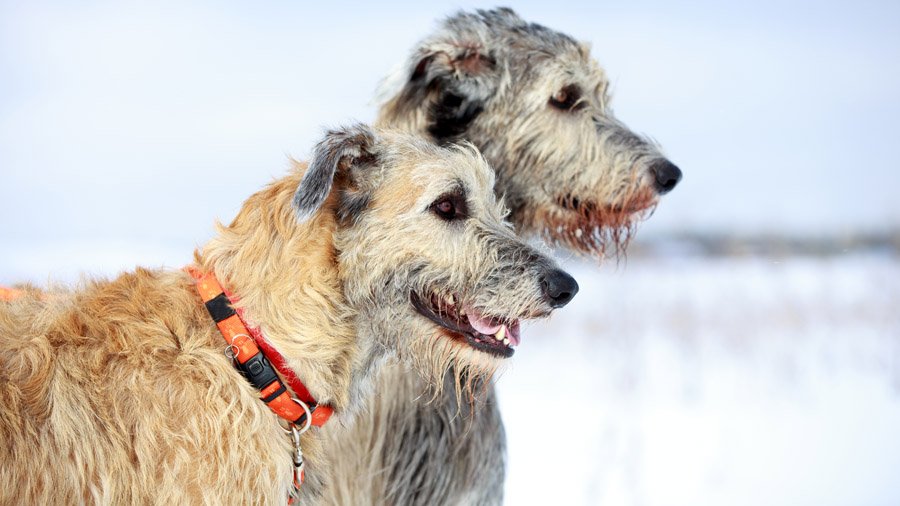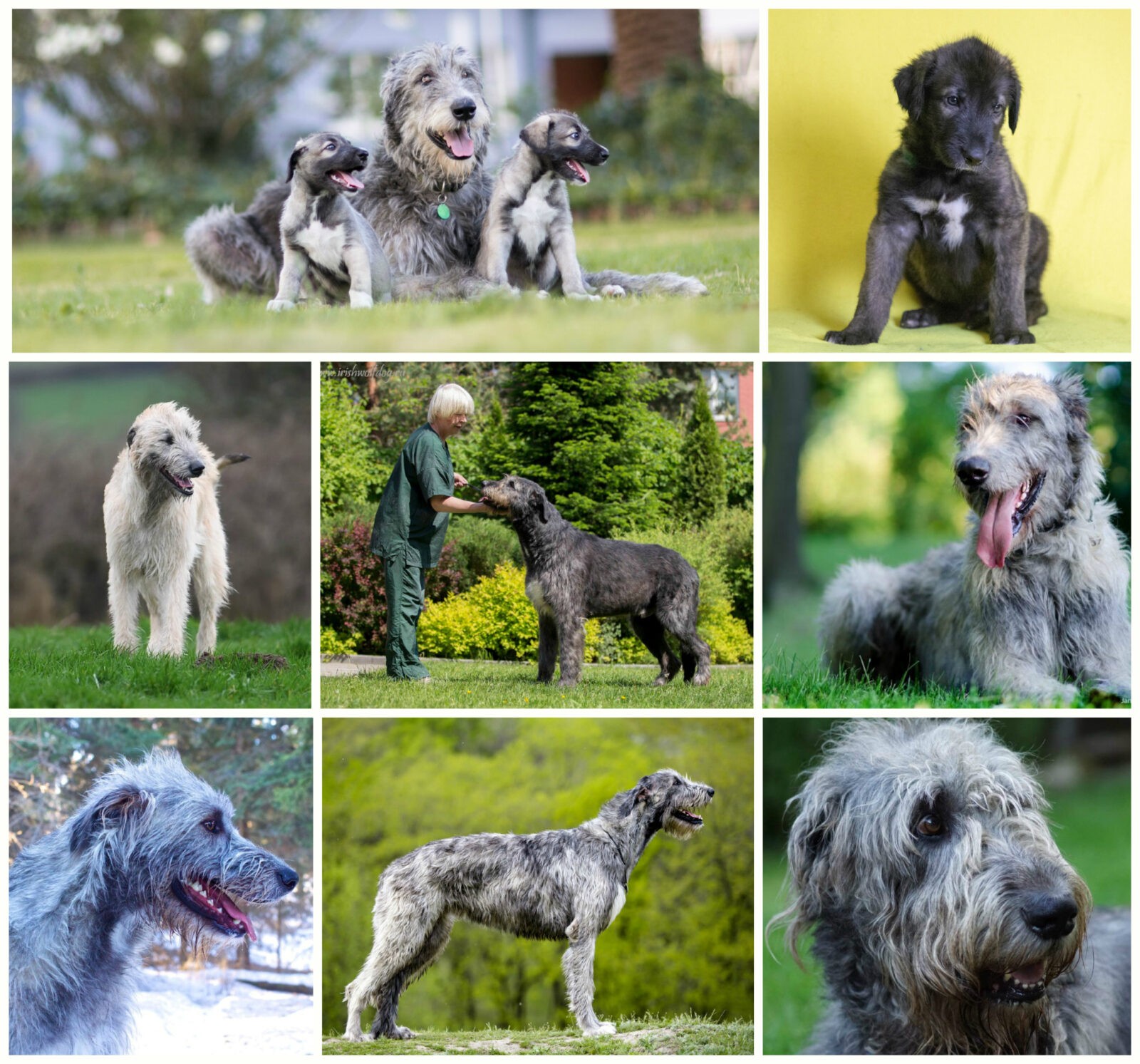
Brief description of the Irish wolfhound breed
Irish Wolfhounds combine two main parameters - they are huge, but not evil, such good-natured giants. However, these dogs are very intelligent and perfectly recognize a person who is unfriendly towards them or their owner. Therefore, do not think that the Irish wolfhounds are not capable of repelling the enemy. The growth of Irish wolfhounds is about 81-86 cm, but often exceeds these parameters, therefore, the height at the withers for males is indicated in the Breed Standard - from 79 cm, for bitches - 71 cm and no end limits specified. Weight of males not less than 55 kg, weight of bitches - not less than 40 kg.
Head: long, with poorly defined frontal bones, wide skull. Muzzle: Elongated, narrowed towards the nose. Eyes: oval, dark or light brown in color. Ears: Small, pinkish. Neck: Long, muscular, without dewlap. Body: long, widened at the croup, with well-developed ribs. The chest is wide. The belly is tucked up. Tail: long, medium thick. Extremities: Long, muscular (especially the hindquarters), strong. The forearms and thighs are long and well muscled. Coat: thick, coarse. In the area of the eyes and the lower jaw, the hair is noticeably longer and coarser than on the whole body. Color: white, gray, red, black, light brown, brindle. In appearance, the Irish wolfhound looks like a Scottish deerhound. - the ancient representative of the deer greyhounds.
basic information
| Breed name: | Irish Wolfhound |
| Country of origin: | Ireland |
| The time of the birth of the breed: | 2000 years ago |
| Type of: | greyhounds |
| The weight: | 40 - 55 kg |
| Height (height at the withers): | 71 - 86 cm |
| Life Expectancy: | 6 - 10 years old |
|
ICF classification:
|
Group 10, Section 2, Number 160 |
| Puppies price: | 100 – 1100 $ |
| Most popular nicknames: | Irish Wolfhound Nickname List |
Assessment of the characteristics of the Irish wolfhound breed
| Adaptability
(a definition meaning how easily a dog can adapt to changes in life) |
🐶🐶🐶🐶 |
| Shedding level
(Level and frequency of hair loss in the animal) |
🐶🐶 |
| Tenderness level
(The level and amount of tenderness and affection that the dog gives in return for attention to itself) |
🐶🐶🐶🐶🐶 |
| Exercise needs
(Dog's daytime activity level) |
🐶🐶🐶 |
| Social need
(The required number of contacts of the dog with other animals, as well as people) |
🐶🐶🐶 |
| Apartment content
(A factor that determines the level of noise and other inconveniences that a dog can deliver to owners in relation to the size of the apartment to the size of the dog) |
🐶🐶 |
| Grooming
(The number of bathing, brushing, and the number of professional grooming sessions required for the dog) |
🐶🐶🐶 |
| Friendliness in an unfamiliar environment
(Features of the behavior of a dog in a society with strangers or in an unfamiliar environment) |
🐶🐶🐶 |
| Tendency to bark
(Tendency to bark and its frequency and volume) |
🐶🐶 |
| Health issues
(Potential health status of the dog) |
🐶🐶🐶🐶🐶 |
| Territoriality
(The dog's tendency to protect his home, yard, or even his owner's car) |
🐶 |
| Friendliness to cats
(The tendency towards tolerance for cats and decreased manifestation of hunting instincts) |
🐶🐶🐶 |
| Intelligence
(The ability of the dog to think and solve emerging difficulties (not to be confused with learning!) |
🐶🐶🐶 |
| Education and training
(The level of difficulty in training the dog to perform certain actions) |
🐶🐶🐶 |
| Friendliness to children
(A factor that determines how friendly a dog is to children, whether he likes to play with them and tolerate some childish pranks) |
🐶🐶🐶🐶 |
| Game activity
(The concept is determined by its very name, and, as a rule, is found in almost all dogs) |
🐶🐶🐶 |
| Observation
(The ability of a dog to detect the presence of a stranger on its territory) |
🐶 |
| Friendliness to other dogs
(The tendency of the dog to find common language with his other relatives) |
🐶🐶🐶🐶🐶 |
Photo of the Irish wolfhound:

Origin story
Irish Wolfhound personality traits
Maintenance and care
It is because of their large size that Irish wolfhounds are most often kept in aviaries on the territory of suburban or private yards. However, if the living space allows, the Irish wolfhound will not bring much trouble to the household. Undoubtedly, these dogs can live in the yard, but there is one caveat. - they need daily communication with the owner and participation in the life of the family (playing with children, being near the owner, etc.). Therefore, even wolfhounds living in the aviary, it is not bad to bring them to the house for the night. Dogwho spent the whole day on the street and spent energy on walks and games in the courtyard will not bring trouble to the owner, will not disturb sleep. Alternative to spending the night in the house - time taken daily to participate in the dog's life.
For grooming, Irish wolfhounds require frequent brushing. Bathing is done no more than 3 times a year using special detergents for dogs. Cleaning your ears, trimming your nails, washing your paws after walking, paying attention to your eyes - all these actions for wolfhounds are carried out as for dogs of other breeds. The Irish are quite clean and unpretentious in their care. Irish people living in an apartment need walks (preferably at least 2 times for 40-60 minutes). The yard dog also needs to be taken outside the fence, perhaps not as often. Sometimes the Irish wolfhound is jokingly used as a carrier or "horse" for children (and sometimes adults). Riding a dog on horseback is not worth it, it is fraught with diseases of the joints and ligaments, since the musculoskeletal system is considered the weak point of massive wolfhounds.
Training and education
Irish wolfhound puppy training should begin from the first days of his stay in the new home. And from the very beginning, the owner of the dog must take care of its socialization. - adaptation to life in society. The owner must patiently train dog to new housing, try to calmly respond to the puppy's fear of new people, animals, things that frighten the baby. It is necessary to kindly reassure a wolfhound puppy when he is overly agitated, because even in the apartment itself he can be frightened by the mass of appliances (washing machine, hairdryer, drill and much more), other pets (especially if they are unfriendly), signals and sirens of cars. You should not hide the puppy from the outside world, communication with other dogs during a walk. The sooner the baby realizes that no one seeks to offend him, the sooner he will get used to a new home and a new life for himself.
Cynologists advise to take a general course of obedience with the Irish wolfhounds, during which the animal recognizes and learns to execute commands such as: “near”, “to me”, “sit”, “lie”, “stand”, “walk”, “place "," Fu "and others. During training, the dogs are often vaccinated with apprehension, training to shoot (if it is planned to participate in hunting for game), overcoming an obstacle course.
Whoever trained - by the owner or professional, the most friendly attitude towards the dog should always be maintained. Irish wolfhounds are not animals that can be spurred on to execute commands by rudeness and aggression. They are often distracted from the trainer's tasks, switching their attention from class to something else, so you have to be patient. By the way, do not try to instill in the Irish uncharacteristic fighting or service qualities. These animals are strong, but not prone to aggression, smart, but not suitable for performing service-search work.
Health and disease
Some interesting facts
- The growth of the Irish wolfhounds is legendary. Despite the fact that the tallest dog is considered the Great Dane (record 105.4 cm), the Irishman did not lose much of the palm. In the early 1920s, an Irish wolfhound dog named Broad Bridge Michael lived in South-East England, whose height at 2 years was 100.3 cm.But even those individuals whose height at the withers does not exceed such gigantic marks look real giants, especially when they stand on their hind legs.
- Since 1908, Irish wolfhounds have served in the Cloverleaf Guard in their historic homeland. They participate in state celebrations and parades, where royals and other nobility are honored.
- About Irish wolfhounds in their homeland they say: "Courageous as a lion and meek as a lamb." In the old days, Irish warriors wore the image of this dogs engraved: "Delicate - in response to affection, terrible - in response to a challenge ”on his armor. Indeed, you can't say better about the Irish wolfhound, whose frightening appearance so frightens the public, and the kind heart is so loved by the owners.
Nurseries and breeders
We borrowed material from the wonderful site of our partners DOGCATFAN.COM about cats and dogs, the author dogcatfan
